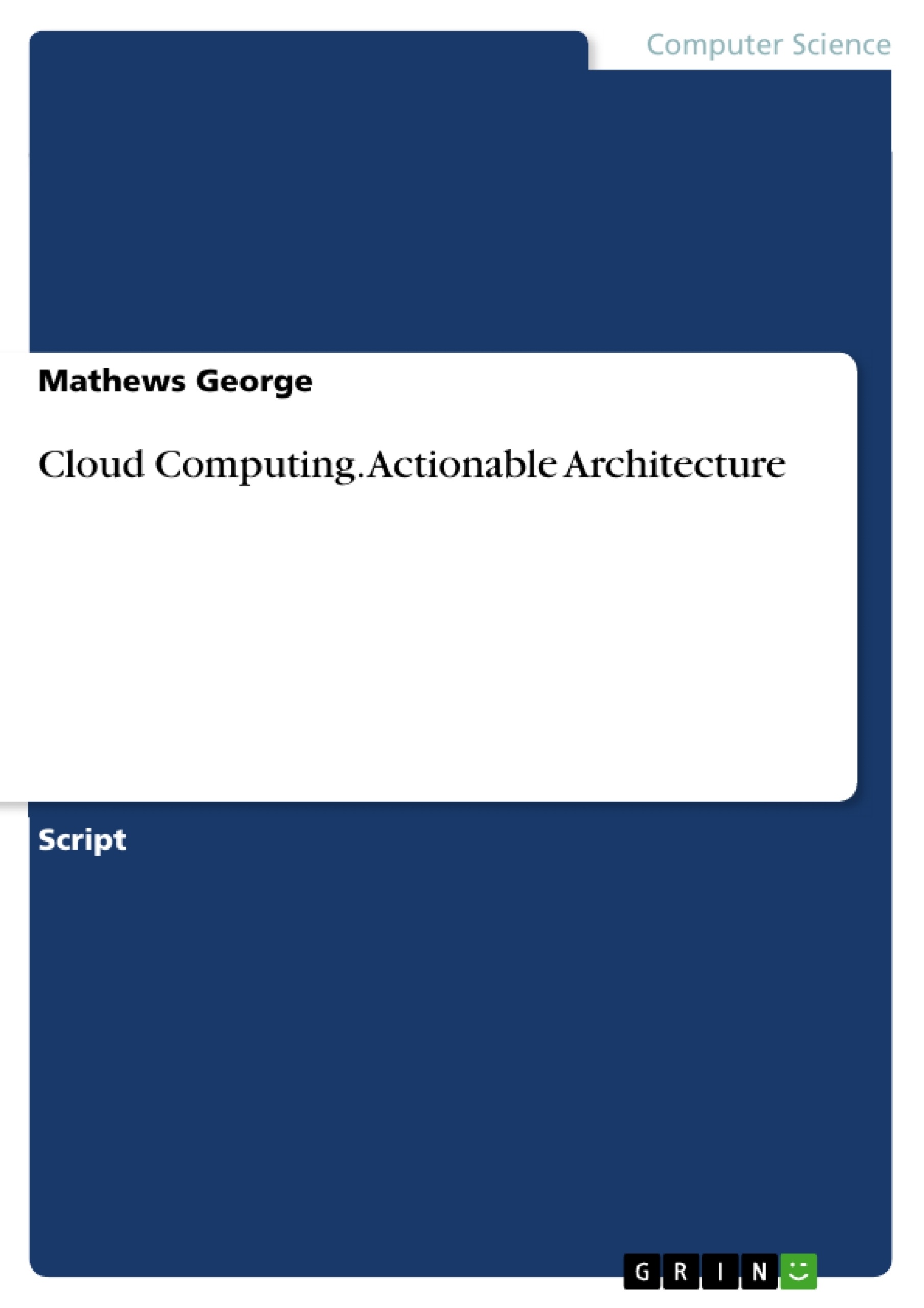This paper will demonstrate a pragmatic methodology, used in conjunction with UML (unified modeling language), BPMN (business process modeling notation) along with engineering principles for describing an actionable architecture for cloud computing in the real world. The fundamental paradigm of cloud computing, whether it is for private or public usage, revolves around the provisioning of services for everyone through rich resources that can be synergized through Internet-based protocols.
The true definition of Cloud Computing is, according to the author, all about the practicalities of “outsourcing” all aspects of using computing resources to some form of external “agency”. This means that the assumption for any cloud computing usage is the fact that the “agency” has a powerful resource base (hardware, software, infrastructure, platforms, power supply, backups, failover mechanisms as well as management skills). Therefore, all users of the cloud computing services provided by the “agency” can work in a well-defined “demand-supply” mode, with an insurmountable base of possible fault-tolerant mechanisms to support best possible user experiences. The user will have the unique experience of not being worried about where his/her work is being done because cloud computing, as defined above, will enable him/her to work in a “virtualized” environment but with the feeling of being close to the resources.
However, the apparent ease available through cloud computing will raise problems associated with diverse types of risks. Hence, it is imperative to define new architectural blueprints as well as the associated business processes around them so as to provide measurable metrics that will allay the fears of any user. The architectural blueprint is not just meant to be a lot of diagrams and documents but they are to be modeled as actionable artifacts. These actionable artifacts will allow for operational excellence that covers all types of functional as well as non-functional requirements that any user expects. The MDA (model driven architecture) approach, coupled with BPM (business process modeling) and engineering principles, as posited in this paper, will allow for management of distributed communication, scheduling, security enhancements and rights (as well as many other aspects) that will make the user experience enjoyable and successful.
Inhaltsverzeichnis (Table of Contents)
- Introduction
- Purpose
- Business Drivers
- CSB (Cloud Service Bus) - Formalism
- BPM (Business Process Modeling)
- Use Case Model (Requirements)
- Sequence Model (Scenarios)
- Component Model
- Deployment Model
- CSB Model Driven Architecture
- Conclusion
- References
- Citations
- Acknowledgements
Zielsetzung und Themenschwerpunkte (Objectives and Key Themes)
This paper aims to propose a practical architecture for cloud computing, demonstrating how it can be implemented in the real world. It explores the use of UML (Unified Modeling Language), BPMN (Business Process Modeling Notation), and engineering principles to create actionable artifacts for this architecture.- The Practicalities of Cloud Computing and "Outsourcing"
- The Role of the Cloud Service Bus (CSB) in Cloud Computing
- Actionable Architecture for Cloud Computing: Combining UML, BPMN, and Engineering Principles
- The Significance of Business Processes and Models in Cloud Computing
- The Importance of Fault Tolerance and Reliability in Cloud Computing
Zusammenfassung der Kapitel (Chapter Summaries)
- Introduction: This chapter establishes the purpose of the paper, emphasizing the need for a practical and actionable cloud computing architecture. It highlights the existing limitations of current cloud computing implementations and introduces key concepts like "outsourcing" and the Cloud Service Bus (CSB).
- CSB (Cloud Service Bus) - Formalism: This section delves into the formal definition and characteristics of the CSB. It explains its role as a central component in cloud computing infrastructure, facilitating the delivery of various services.
- BPM (Business Process Modeling): This chapter discusses the importance of business process modeling in cloud computing. It explores how BPM can be integrated with the architectural design, enabling effective management of complex processes and requirements.
- Use Case Model (Requirements): This section focuses on the development of a use case model for cloud computing. It outlines the various functionalities and user requirements that the architecture needs to address.
- Sequence Model (Scenarios): This chapter describes the sequence diagrams and scenarios that illustrate the interactions and workflows within the cloud computing system.
- Component Model: This section details the component architecture of the proposed system, outlining its various components and their roles in the overall framework.
- Deployment Model: This chapter presents the deployment model for the cloud computing architecture, explaining how the components are deployed and interconnected.
- CSB Model Driven Architecture: This section provides a comprehensive overview of the CSB model-driven architecture, highlighting its principles and how it integrates with the other architectural aspects.
Schlüsselwörter (Keywords)
Cloud computing, actionable architecture, Cloud Service Bus (CSB), Unified Modeling Language (UML), Business Process Modeling Notation (BPMN), enterprise architecture, business process management, fault tolerance, model driven architecture, "outsourcing," user requirements, virtualized environment, programmable models.- Quote paper
- Mathews George (Author), 2011, Cloud Computing. Actionable Architecture, Munich, GRIN Verlag, https://www.hausarbeiten.de/document/262815


